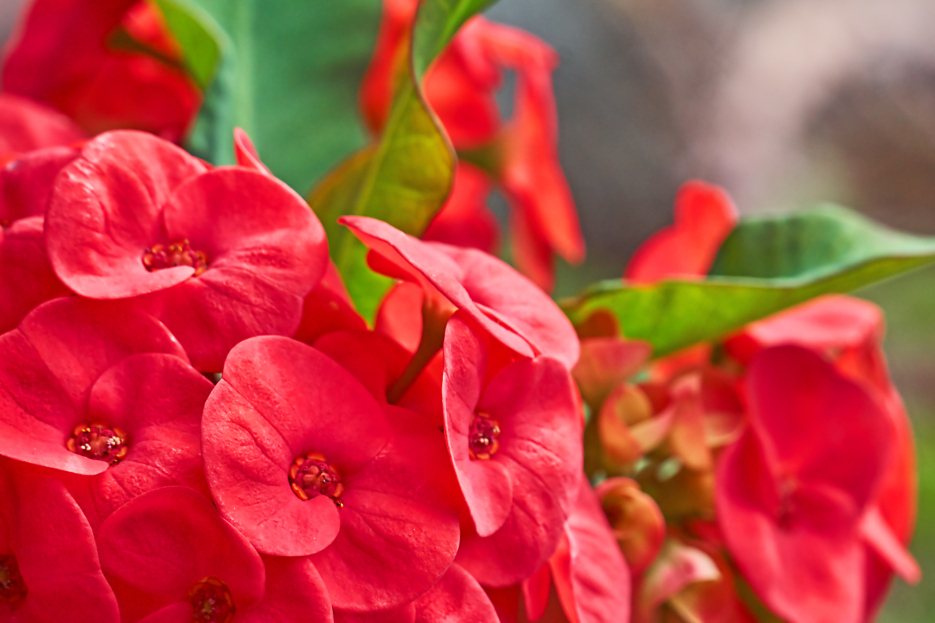
The Crown of Thorns (Euphorbia milii) is a popular succulent known for its unique appearance and vibrant flowers. Native to Madagascar, this hardy plant is ideal for both beginner and experienced plant enthusiasts due to its low-maintenance nature and ability to thrive in various conditions. With spiny stems and colorful blooms ranging from red and pink to yellow and white, it’s a striking addition to any home or garden. Here’s a comprehensive guide to help you care for your Crown of Thorns plant and enjoy its beauty year-round.
Crown of Thorns plants thrive in bright, indirect light but can tolerate several hours of direct sunlight each day. Plenty of light is essential for producing its signature colorful blooms. Indoors, it’s best to place the plant near a south- or west-facing window where it can receive bright sunlight. If your plant isn’t flowering, it may not be getting enough light, so consider moving it to a brighter spot. For outdoor care, ensure the plant receives partial to full sunlight, ideally around 4-6 hours of sun daily.
As a succulent, the Crown of Thorns is highly drought-tolerant and prefers to dry out between waterings. Overwatering can lead to root rot, so it’s important to avoid excess moisture. Water your Crown of Thorns when the top 1-2 inches of soil feel dry. During the warmer months of spring and summer, you may need to water your plant more frequently, while in winter — when the plant’s growth slows — watering should be reduced. Always ensure the pot has proper drainage to let excess water escape, and if growing indoors, use room temperature water to prevent shocking the plant.
A well-draining soil mix is crucial for a healthy Crown of Thorns. As a succulent, it dislikes soggy soil, and poor drainage can quickly lead to root rot. A cactus or succulent mix works best, or you can create your own by blending potting soil with sand or perlite. When choosing a pot, ensure it has drainage holes. A pot that’s too large can retain too much moisture, so it’s better to select one that fits the plant’s current root system.
Crown of Thorns plants flourish in warm temperatures and low to moderate humidity. They are not frost-tolerant and can be damaged by cold drafts or chilly conditions. The ideal temperature range is between 65-95°F (18-35°C), and it’s important to keep the plant away from areas where temperatures may drop below 50°F (10°C). Fortunately, this plant adapts well to average indoor humidity and doesn’t require extra moisture, making it perfect for most home environments.
To support healthy growth and vibrant blooms, Crown of Thorns plants benefit from regular feeding during the growing season, which spans from spring to summer. A balanced, water-soluble fertilizer diluted half strength works well, and feeding every 4-6 weeks keeps the plant thriving. It’s important to avoid fertilizing during winter when the plant’s growth naturally slows. Over-fertilizing can cause leggy growth and reduce blooming, so it’s best to stay within the recommended feeding schedule.
Occasional pruning helps Crown of Thorns plants stay neat and encourages more blooms. Since the plant has thorny stems, wearing gloves while handling it is a good idea. Prune any dead or yellowing leaves to keep the plant looking tidy, and cut back long, leggy stems to promote a bushier shape. Removing spent blooms also encourages new flower production. If you want to propagate your Crown of Thorns, you can take stem cuttings and root them in well-draining soil for a new plant.
If you notice yellowing leaves, it’s often a sign of overwatering or poor drainage. Ensure the plant isn’t sitting in water and adjust your watering schedule if needed. A lack of blooms usually means the plant isn’t receiving enough light, so moving it to a sunnier spot can help. If the plant becomes too leggy, pruning can encourage more compact growth. Crown of Thorns is also prone to pests like mealybugs, aphids, and scale. If you spot any pests, treat the plant with neem oil or an insecticidal soap to prevent further damage.
Crown of Thorns plants generally need repotting every 2-3 years to refresh the soil and give the roots more space to grow. When repotting, choose a slightly larger pot to allow for future growth. Carefully remove the plant from its current pot, check for any signs of root rot or disease, and trim any damaged roots. Replant it in fresh, well-draining soil, and allow the plant to adjust to its new home before watering again.
While Crown of Thorns plants are beautiful, they are toxic to pets if ingested. The plant contains a milky sap that can cause skin irritation and gastrointestinal upset in animals. It’s best to keep the plant out of reach of pets and small children. When pruning or repotting, always wear gloves to avoid coming into contact with the sap.